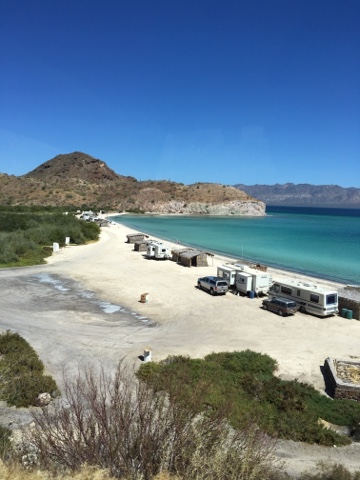Mid-February marks "the rerun of the whale sharks" to Bahia el Coyote! The tell tale rounded and low dorsal fin glides past our campsite at the beach and suddenly the beach is alive with kayakers and paddle boarders.
How to get a better view....respectfully? That seems to be the beach gringo attitude, which is wonderful.
How can I be in the presence of the largest fish in the sea and not want to know more about it? Impossible as it turns out...so here goes:
Although this day we enjoy the visit of two "smaller" whale sharks, the average length of an adult is 31 pfeet or more, weighing about 20 tons. Some have been reported in the 40 ft. range. (Think "school bus size."). Gliding very slowly through the shallow warm water, this juvenile (estimated size by comparison to my 11 ft. Paddle board is 16-20 ft) feeds on plankton and very small fish using a cool filtering system. The mouth can measure over 4 feet across. opening wide, it uses 300-350 rows of tiny tiny teeth, 10 filter pads and 5 gills per side, to catch it's prey. On the yummy list? That would be: zooplankton, phytoplankton, krill, copepods, fish eggs, and small squid and fish.
There are two feeding strategies: ram filteration where the shark swims with an open mouth directly into the food source or suction filteration which can be accomplished with the fish almost motionless....except for moving gills and swirling water. I see both from atop my board! Awesome!
Each animal has a pattern of dots that is specific to that individual. As with the orca whales at home....very hard for the untrained eye to tell the difference. There is the beginning of an ID program with Whale Shark Mexico in LaPaz, BCS.
The juveniles have a longer upper tail fin and shorter lower fin, where the adults have equal length fins. (Check out the tail in the photos) this year we see only juveniles, according to tail fin observation.
Gliding by Coyote Beach in late February.
Two boys and a whale shark in the Sea of Cortez, Conception Bay.
Wayne and his little kayak....and the 20+ foot whale shark!
Whale sharks are found in warmer water, mostly around 30 degrees latitude. Here's where you can go to find one for yourself: South Africa, St. Helena, Belize, West Australia, India, Hondouras, Phillipines, Madagascar, Mozambique, Zanzibar, or....Coyote Beach, Baja!!!
They may be diving down to depths of 4,219 feet, or gliding just below the surface, teasing you with that dorsal fin or the wave of the top of the tail fin.
There is no global population estimate. As many as 300 pups have been found inside a deceased female. It's thought that they give birth individually over a prolonged period, to live pups measuring 16-24 inches. They don't reach sexual maturity until 30 years of age and may live between 70 and 100 years! Neither mating nor pupping have been observed. They are listed as "Vunerable Species."
In the Vietnamese culture the whale shark is revered as a diety and called "Ca Ong" meaning Lord Fish." The Philippines put this awesome creature on the back of the 100 peso bill and by law snorkelers must keep a 4 foot distance. Touching a whale shark will earn you a fine or possible jail time.
We can't easily discover Mexican rules or regulations having to do with whale sharks. They do advertise "Swim with the whale sharks" on a building in Mulege. Once we witness a Mexican boat race up to one of the whale sharks, a swimmer jumps in and hangs on to the whale shark by the edge of the mouth and goes for a ride. This is a sad time. There is an uproar from folks on the beach, shouting....and when the swimmer gets out, there is a rude exchange...they are Gringos.
For the most part, as these beautiful creatures grace our bay, from January 31st until the day we leave, March 12th, it is a magical experience.
























































